FROM POLICE OFFICER TO FISHERMAN ON A LUMPFISH BOAT

In late autumn 2019, our sea angling boat Aþena was taken out of the water and brought to Reykjavík, where she was modernised with a new engine and received a general beauty treatment at the same time.
Earlier in March, she finally returned to her home port here in Húsavík.
Before as usual serving as a sea angling boat again during the summer months, Aþena as well takes part in the annual lumpfish season, which has just started these days.
After she was fully equipped for her duty as a commercial fishing vessel earlier last week, Aþena left the port for her first trip of lump fishing a few days ago.
It doesn't come as a surprise that fishing is one of the key industries in Iceland – but have you ever wondered what it is like to head out onto the North Atlantic Ocean on a small fishing vessel in order to retrieve your catch?
Brett Alan Parson, a retired police officer from Washington, DC and friend of Stefán Guðmundsson – Gentle Giant’s CEO and captain onboard Aþena – asked himself the same question and to find an answer, decided to try himself as part of the crew.
“In my 52 years, I have worked hard, at times. […] I have felt pain. I have known what it is to be dedicated to a mission and perform tasks in difficult, sometimes dangerous conditions and circumstances. NEVER in my life have I worked so hard for such a sustained period of time, under the most extraordinary of conditions. Until, I boarded the Aþena and worked with her crew catching lumpfish in the Atlantic Ocean:
The alarm rang at 4 a.m. Saturday morning. I was already awake, as I was excited for the upcoming day, my first lump fishing journey. "Brett, we are delayed one hour. There are high winds right now. We will depart at 6 a.m." Stefán was already up and evaluating conditions, most importantly looking out for the welfare of his vessel and crew. At 5:30 a.m., we drove the 3 minutes down to the docks, where we met the rest of the crew (Jose, Gunnar, and Reynir). We loaded the final equipment and provisions on board and pushed off at 6 a.m. It was dark, with temps below freezing, windy, with choppy seas. The cruise to the first buoy took about 90 minutes. We (the four deckhands) went below deck to rest/sleep. Below deck is under the front of the boat. The clearance is just enough to stand and just wide enough that when one spreads his arms, your arms can barely reach both sides. There are two bunks above two bench seats. Our crew leader (Reynir) and most senior crew member (Gunnar) took the top bunks. I contorted my body to lay on one of the bench seats, which was half the length of my body. I balled up my rain coat and placed it under my head for a pillow and closed my eyes. I slept, but haltingly. Every few minutes, the boat would lurch up, down, or side-to-side with such force that I would roll of the bench or be launched upward such that my head struck the bunk above me.
At about 7:30, Stefán turned on the lights below deck and yelled something in Icelandic. […] Like firefighters waking from a sound sleep, jumping into turn-out gear, and running to the apparatus, we quickly moved to the deck. My crew mates went out ahead of me, as I took a bit l longer to jump into my rubber boots, bib, hat, and gloves. Once bundled up, I started out. "Have fun and follow their instructions," Stefán said. He was smiling like a proud father. "Yes Captain!" I responded. Out I went for my first day of harvesting lumpfish from the North Atlantic.
To be honest, I have worked in tough conditions. I have officiated games in sub-zero weather, policed in hurricanes, snow storms, and incredible heat. I have endured difficult obstacles to get my job done, been shot at, punched, had food and fences thrown at me, been stabbed ...NOT LIKE THIS! Imagine a ping-pong ball inside a blender. That is what it feels like you are trying to balance on as you stand on the deck of a small fishing boat in rough seas […] While holding on to the rails or anything secure, the wind and seawater are blowing in your face, as rain, sleet, and snow come from every direction. It is cold, slippery, and with the hood up, difficult to communicate. You use every muscle in your body just to maintain your balance. This is before the 'work' even begins. All communication is done using hand signs or by yelling. There is no room for inattentiveness or miscommunication.
Within minutes, it starts. The engines die down and we pull up to the first buoy, marked '1'. Reynir leans over the rail, as Gunnar stands near with a gaff (long pole with a hook on the end). Reynir grabs the buoy and hoists it about like pulling a drowning person from the water. […] He is quick, strong, and experienced. I am in awe! He tosses the buoy effortlessly onto the top of the processing table in the middle of the deck. The race begins.
Jose and Gunnar quickly untie the buoy, throw the buoy in the rear rope bucket, and move the end of the rope into the hydraulic line hauler, as Reynir simultaneously wraps the line around the hydraulic wench. The net is coming up. First is the 30 pound stone that holds the net down in the sea. It must be untied quickly and thrown in the bucket with the retrieved buoy, before the net emerges. Within seconds, it does.
[…]
The net moves slowly, but steady. Immediately, the first catch is on board, falling out onto the table, where Jose, Gunnar, Reynir, and I are standing awaiting the arrival of our bounty. It is a lumpfish, our target. A photo of a lumpfish [follows below], but let me try to describe it. They weigh anywhere between 15-25 pounds each. They are round (picture a duck pin bowling ball), with tiny side fins, a short tail fin, and a little dorsal fin that make is look like it has a mohawk. It has bulging eyes on either side of its "head." It is not easy to figure out which side is the head. It is the part with the eyes. The exterior is tough. Imagine the skin of an alligator or elephant. They are not thrashing, in fact the only movement is a swing of the tail fin or the mouth opening and closing briefly. They eyes are wide open, staring at you no matter what the angle. […] That is the point. The first lumpfish is pushed in front of me on the table. Now, the real work begins.
My job is to help remove EVERYTHING from the net. The fish are thrown onto tubs. This is a race. I am armed with two hands gloved in thick rubber gloves and a small wooden piece of wood with a handle on one end and nail protruding from the other. The nail is for ripping the net from the catch. More is coming, so I have seconds to grab hold, flip it around to remove as much net as possible, then start ripping the netting from around the live fish. At first, I am careful. It is a living being, moving, staring at me, breathing, and with feelings. I slowing try to pick the netting away, until Gunnar grabs it from me. "Like this!" He yells over the high winds. He quickly rotates the fish so the rear/tail is on the table and it is face up. He pulls the netting away from the face, palms the face in this hand, and the other hand, uses the nail to rip the netting away, using strong, violent stokes downward […]. He takes seconds and frees the fish from the netting, tossing it into the bucket. There are now 5 lumpfish, 2 large cod, a flounder, and several spiked sea urchins that have accumulated on the table. We have to move. No time for lessons. This is on the job training.
For the next 15 hours, this is the routine. Each net takes 25-30 minutes to lift and clear. 90% of the catch are lumpfish, while the rest is cod, flounder, haddock, wolf fish, crabs, sea urchin, seaweed, and other species I did not recognize. There is limited by-catch. Of note, we are looking for female lumpfish. After clearing the net, it needs to be returned to the sea to catch more fish and be picked up again in a couple of days. That takes another 10-15 minutes. Once the net is back in the water, we speed to the next net. It starts again. We get about a 3 minute break while speed to the next buoy […]. We do this 21 times.
[…]
At 9:30 p.m., […] [w]e began throwing the catch into the cargo hold below deck, while counting every fish. Stefán estimates we caught about 3,500 kilo (7,700 lbs.). The return trip is slow, as Aþena is loaded down and bottom heavy. The crew cleans the deck and secures everything for the return to Húsavík Harbor. We go below deck again and rest. The sea is rougher than our outward cruise, with driving winds, high seas, and because we are low in the water, waves are crashing over the bow every few seconds. I slept well."
"My friendship with Stefán goes back over 36 years, as we met while he was an exchange student in the US, staying with my cousins. I knew my friend was a fisherman and captain. I never knew what that really meant until yesterday. It is a gruelling job, with long hours, physical challenges, and danger. Whether swinging tons of cargo about your heads or balancing on board a small boat in the middle of the freezing sea, they do it with ease. Add they do it in all weather and in smooth and incredibly high seas, you have men who are among the toughest professionals I have ever met.”
Story by Brett Alan Parson
Photos by Brett Alan Parson and Stefán Gudmundsson
- Sarah
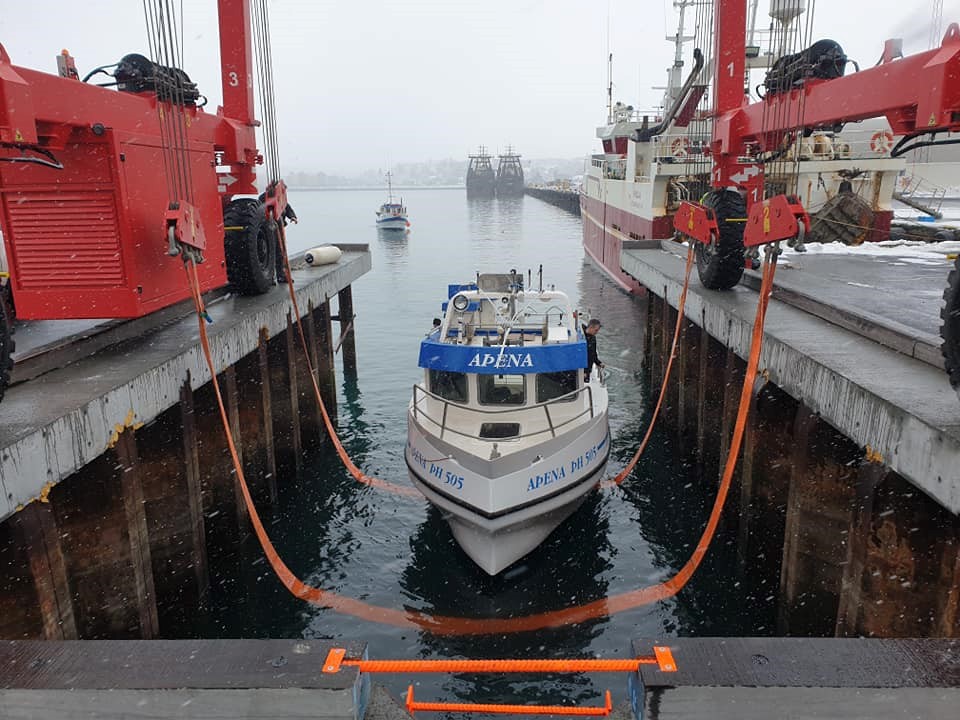
Before she was brought back to Húsavík earlier in March, Aþena's new engine was tested in Reykjavík.
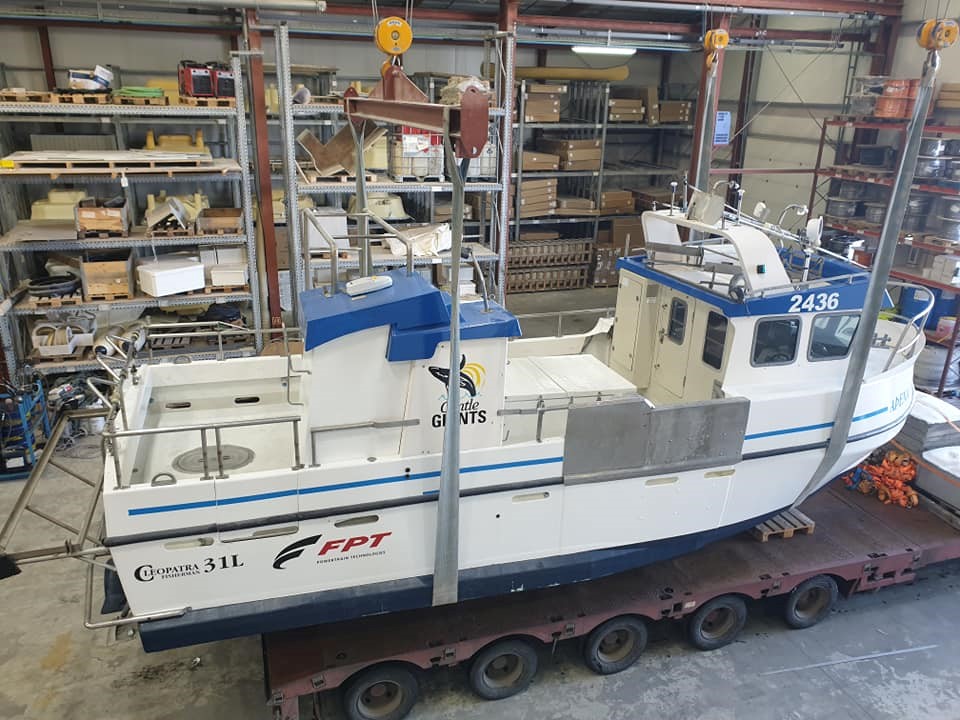
Aþena loaded on a lorry, ready to be transported back to her home port here in Húsavík.
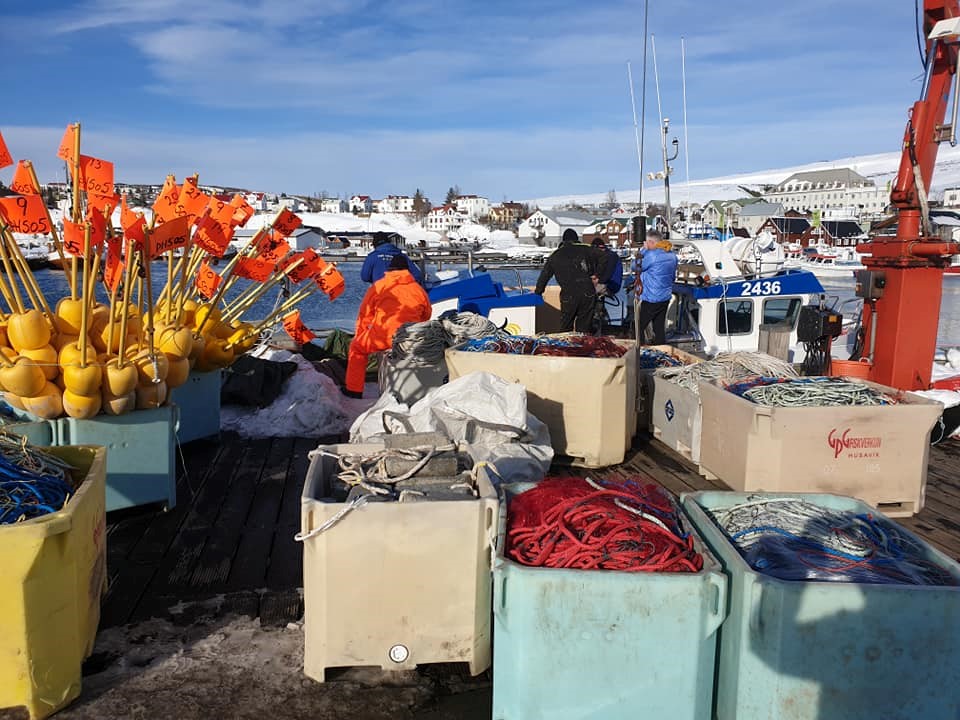
Short after arrival, preparations began to get Aþena equipped for her duty as a fishing boat during lumpfish season.
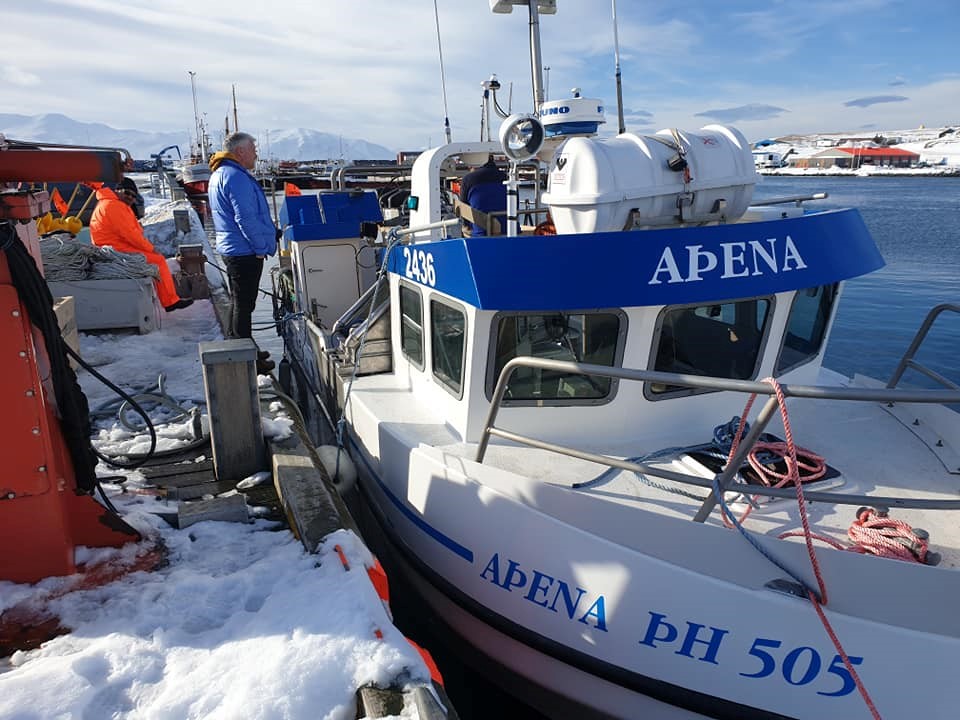
Short after arrival, preparations began to get Aþena equipped for her duty as a fishing boat during lumpfish season.
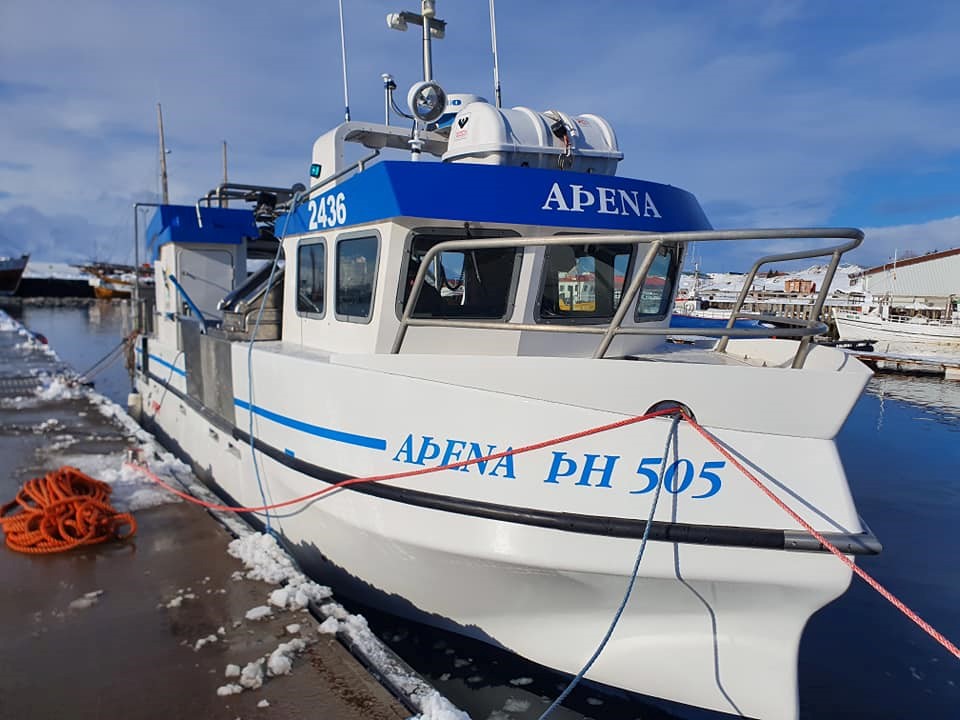
Back to the dock, Aþena is ready for her first trip of the annual lumpfish season.
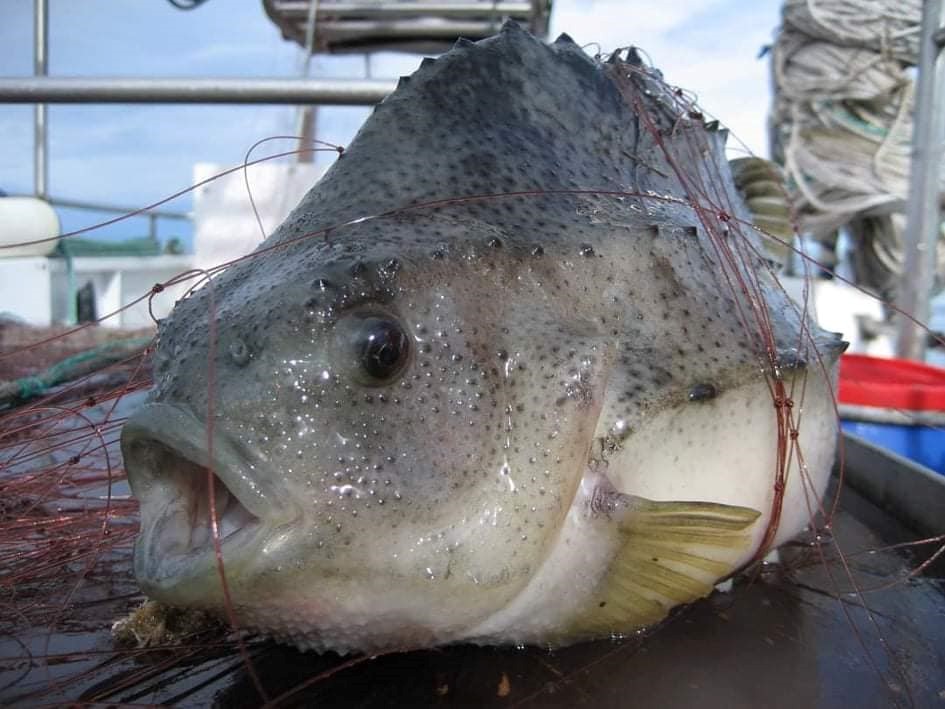
By the end of last week, the crew went out to retrieve their first catch. The photo shows a lumpfish.
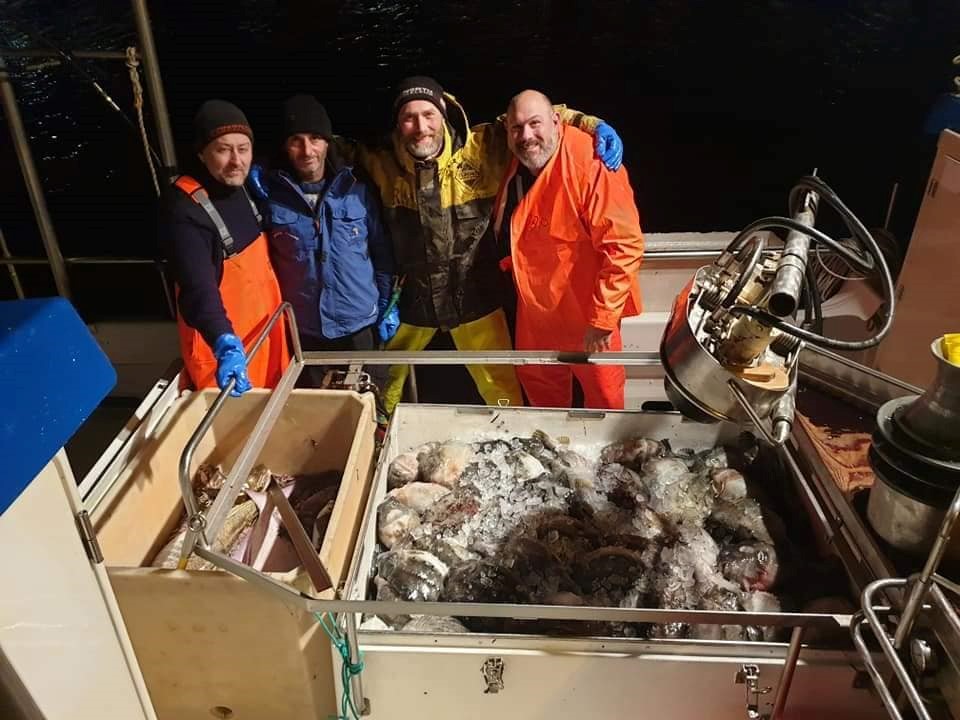
Days are long out at sea: after having left in the early morning, Aþena returned to port late in the evening after a successful day of fishing. The photo shows the deckhands Gunnar, Jose, Reynir and Brett (left to right).
